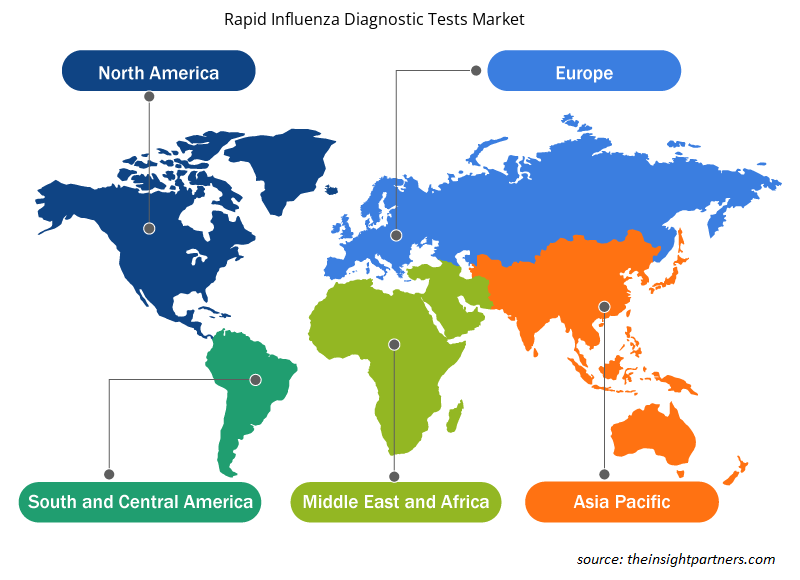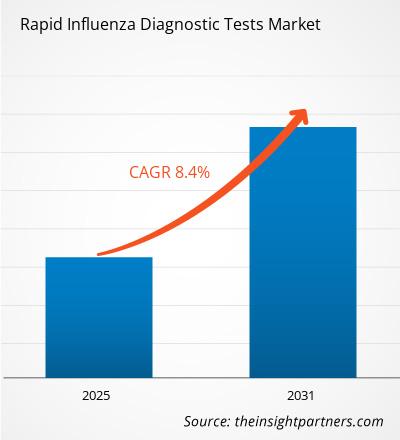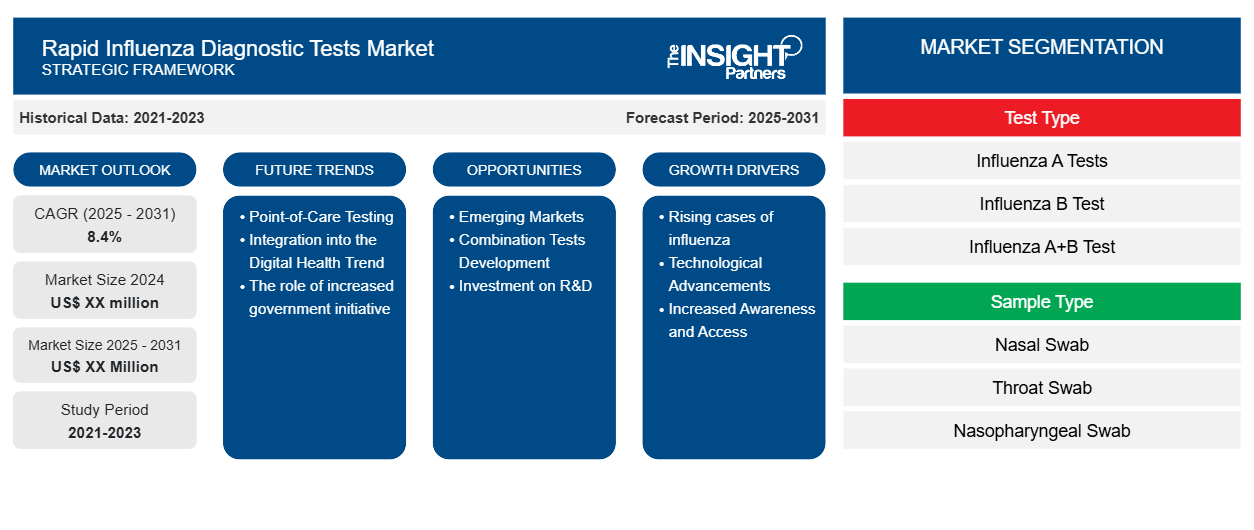快速流感诊断检测市场预计在 2024 年至 2031 年期间的复合年增长率为 8.4%,市场规模将从 2024 年的 XX 百万美元扩大到 2031 年的 XX 百万美元。
报告按类型(液压、手动、电子)细分。报告进一步根据应用(牙科实验室、医院、其他)进行分析。全球分析进一步细分为区域和主要国家。报告提供上述分析和细分的美元价值。
报告目的
Insight Partners 发布的《快速流感诊断检测市场》报告旨在描述当前形势和未来增长、主要驱动因素、挑战和机遇。这将为各种业务利益相关者提供见解,例如:
- 技术提供商/制造商:了解不断变化的市场动态并了解潜在的增长机会,从而能够做出明智的战略决策。
- 投资者:对市场增长率、市场财务预测以及整个价值链中存在的机会进行全面的趋势分析。
- 监管机构:监管市场政策和警察活动,旨在最大限度地减少滥用行为,维护投资者的信任和信心,维护市场的完整性和稳定性。
快速流感诊断测试市场细分
测试类型
- 甲型流感检测
- 乙型流感检测
- A+B 型流感检测
样品类型
- 鼻拭子
- 咽拭子
- 鼻咽拭子
- 其他的
技术
- 免疫层析检测
- 免疫荧光检测
- 核酸扩增检测
最终用户
- 医院和诊所
- 诊断中心
- 养老院
- 其他的
定制此报告以满足您的需求
您可以免费定制任何报告,包括本报告的部分内容、国家级分析、Excel 数据包,以及为初创企业和大学提供优惠和折扣
- 获取此报告的关键市场趋势。这个免费样品将包括数据分析,从市场趋势到估计和预测。
快速流感诊断测试市场增长动力
- 流感病例不断增加:流感感染率不断上升,尤其是季节性爆发,导致对其快速诊断检测的需求不断增加。还需要对感染进行早期和有效的治疗;因此,快速流感诊断检测已成为医疗保健提供者为改善患者治疗效果和改善临床工作流程而采用的重要工具。
- 技术进步:诊断领域的发展,例如改进的、用户友好的快速流感检测,正在帮助促进市场的增长。这种进步可以更快地获得结果,灵敏度更高,因此是临床和护理点环境中的必备品,越来越多的医疗保健专业人员开始使用这种检测方法。
- 提高认识和获取途径:更多患者和医疗服务提供者认识到早期诊断流感的重要性,这是市场增长的主要原因。通过零售药店和诊所获取更多信息,确保快速检测,使这些服务更有可能被使用,并增强流感季节的公共卫生应对措施。
快速流感诊断检测市场未来趋势
- 即时检测:快速流感诊断检测市场随着即时检测的出现而不断向前发展。便利性和速度一直推动着医疗保健提供商采用即时检测,以便即时获得结果帮助他们立即做出治疗决策,并改善患者护理以及临床环境中的资源管理。
- 融入数字医疗趋势:快速诊断测试越来越多地与数字医疗技术(如移动应用程序和远程医疗)结合使用。它解决了更好的数据管理问题;通过将医疗咨询与患者相结合来进行远程咨询;它能够有效地监测流感病例;总的来说,它增强了医疗服务并吸引患者参与。
- 政府举措的增加发挥的作用:政府在资助和宣传活动方面的增加推动了快速流感诊断检测的使用。这些举措的增加加强了对流感爆发的监测和控制,从而鼓励所有公共和私人机构开发和提供这些检测。
快速流感诊断测试市场机会
- 新兴市场:新兴市场医疗基础设施的快速发展为快速流感诊断测试提供了巨大的机会。各地区在改善医疗保健方面的投资不断增加,对此类有效诊断工具的需求不断增加,为制造商开拓新市场和新客户打开了空间。
- 组合检测的开发:组合检测将使制造商能够设计出能够同时检测出多种呼吸道疾病病原体(如流感)的检测。因此,这项创新将解决医疗保健提供者在呼吸道疾病爆发时最需要的广泛而全面的检测解决方案的问题。
- 研发投资:用于诊断研究的较新的先进技术将吸引更多的研发投资。因此,它们可以在快速流感诊断测试市场开辟新的途径,更加注重测试结果的准确性、快速检测和易于处理,以吸引医疗保健提供者在流感季节提供更好的公共卫生管理。
快速流感诊断测试市场区域洞察
Insight Partners 的分析师已详尽解释了预测期内影响快速流感诊断检测市场的区域趋势和因素。本节还讨论了快速流感诊断检测市场在北美、欧洲、亚太地区、中东和非洲以及南美和中美的细分市场和地理位置。

- 获取快速流感诊断测试市场的区域特定数据
快速流感诊断测试市场报告范围
| 报告属性 | 细节 |
|---|---|
| 2024 年的市场规模 | XX 百万美元 |
| 2031 年市场规模 | XX 百万美元 |
| 全球复合年增长率(2025 - 2031) | 8.4% |
| 史料 | 2021-2023 |
| 预测期 | 2025-2031 |
| 涵盖的领域 | 按测试类型
|
| 覆盖地区和国家 | 北美
|
| 市场领导者和主要公司简介 |
|
快速流感诊断测试市场参与者密度:了解其对业务动态的影响
快速流感诊断检测市场正在快速增长,这得益于终端用户需求的不断增长,而这些需求又源于消费者偏好的不断变化、技术进步以及对产品优势的认识不断提高等因素。随着需求的增加,企业正在扩大其产品范围,进行创新以满足消费者的需求,并利用新兴趋势,从而进一步推动市场增长。
市场参与者密度是指在特定市场或行业内运营的企业或公司的分布情况。它表明在给定市场空间中,相对于其规模或总市场价值,有多少竞争对手(市场参与者)存在。
在快速流感诊断测试市场运营的主要公司有:
- 迪亚索林公司
- 碧迪公司
- SA科学
- 科瑞斯生物概念
- Meridian Bioscience 公司
免责声明:上面列出的公司没有按照任何特定顺序排列。

- 获取快速流感诊断测试市场顶级关键参与者概述
主要卖点
- 全面覆盖:报告全面涵盖了快速流感诊断测试市场的产品、服务、类型和最终用户的分析,提供了整体概况。
- 专家分析:报告基于对行业专家和分析师的深入了解而编写。
- 最新信息:该报告涵盖了最新信息和数据趋势,确保了其与业务的相关性。
- 定制选项:此报告可以定制以满足特定客户要求并恰当地适应业务策略。
因此,快速流感诊断检测市场研究报告有助于引领解读和了解行业情景和增长前景。尽管可能存在一些合理的担忧,但本报告的总体优势往往大于劣势。
- 历史分析(2 年)、基准年、预测(7 年)及复合年增长率
- PEST和SWOT分析
- 市场规模、价值/数量 - 全球、区域、国家
- 行业和竞争格局
- Excel 数据集
近期报告
客户评价
购买理由
- 明智的决策
- 了解市场动态
- 竞争分析
- 客户洞察
- 市场预测
- 风险规避
- 战略规划
- 投资论证
- 识别新兴市场
- 优化营销策略
- 提升运营效率
- 顺应监管趋势





















 获取免费样品 - 快速流感诊断测试市场
获取免费样品 - 快速流感诊断测试市场